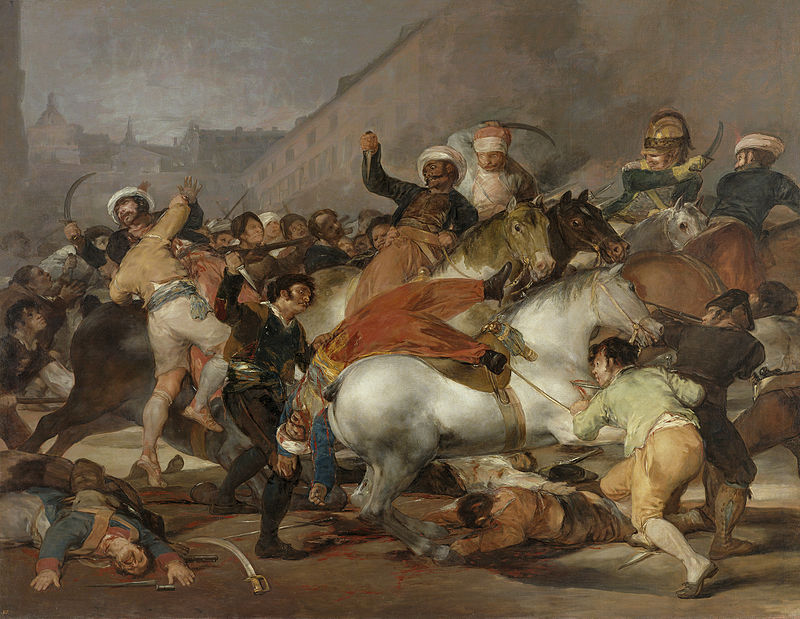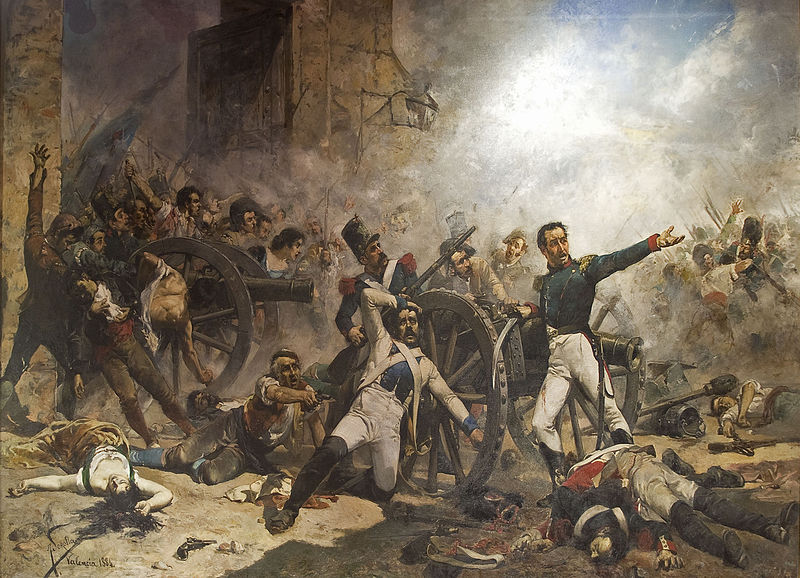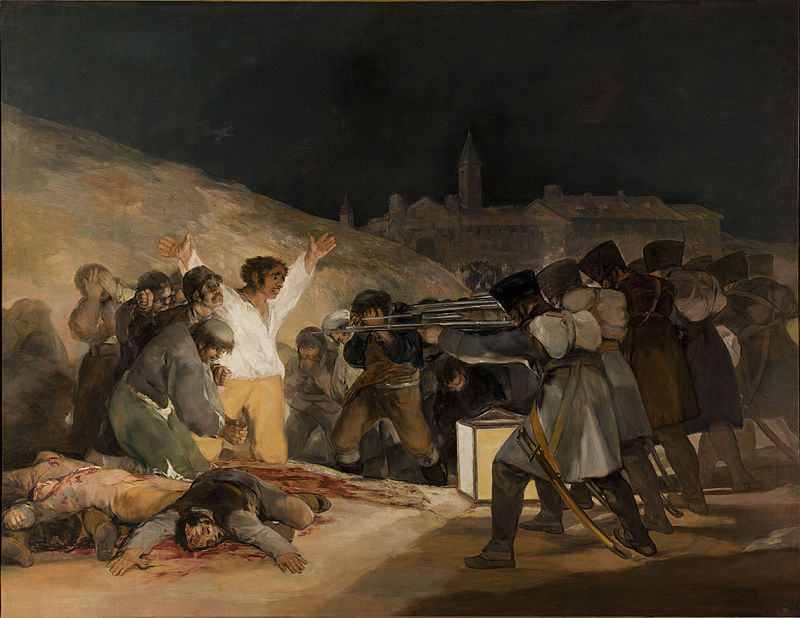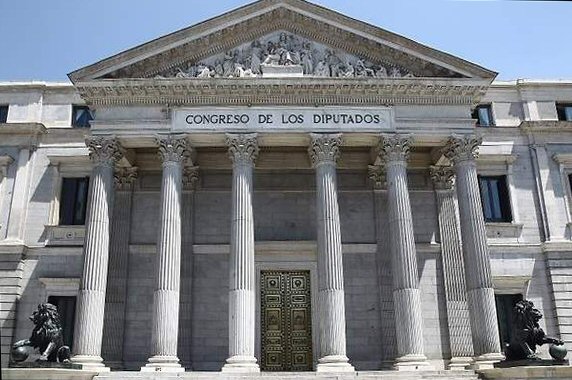On the 2 May 1808 the people of Madrid learned that the 26 year-old Infanta, Maria Luisa, daughter of King Charles IV, was to be taken to Bayonne to join the rest of the Spanish Royal Family. They began to gather around the Royal Palace to prevent her from leaving, but the Spanish palace guard, who would normally escort royalty, had been ordered to remain in their barracks and cooperate with the French by the local Spanish junta. The French were deeply unpopular, and there had been several incidents in the city which had, so far, amounted to no more than brawls and insults. In anticipation of trouble, Marshal Murat had deployed his troops to various parts of the city, but as the crowd grew outside the palace he ordered a contingent of musket armed soldiers into the plaza in an effort to keep the crowd under control.
The mood changed when they realised that the French would be entering the palace to take the infanta away. The mob blocked the gates to stop the French from entering and the crowd became more belligerent. On that fateful morning, something happened to alarm the French troops, who opened fire on the crowd. The British consul, John Hunter, wrote that by 11 am French troops were firing musket volleys in the crowded square and the rioting had spread across Madrid. At the Puerta del Sol, Napoleon’s famed and feared Mamaluk jinetes of the Imperial Guard, comprised of mercenary ex- slaves, charged the rioters and brutally cut them down.

Goya painted the 2 de Mayo and the 3 de Mayo paintings in 1814 within two months of each other, but six years after the event, and long after the French had left Spain. During the occupation, Goya painted very little, but when the war was over, he asked the provisional government if he could show the heroes of the insurrection. He did not paint soldiers or nobles, but the ordinary people in the street who fought the French. He was probably not present in person during the riots, and painted these most famous scenes from eyewitness accounts. Goya was asked to paint portraits of King Ferdinand after he had been reinstated as King of Spain, but Ferdinand did not like either of Goya’s battle scenes, and would not allow them to be shown. For many years they were locked away, and only when other kings and other governments ruled Spain did they see the light of day again. During the 1936 Spanish Civil War, Madrid was bombed, and the paintings were removed from the Prado for safety, but the truck carrying them had an accident and the 2 de Mayo was badly damaged. After the war was it returned to the Prado, where it was repaired and still hangs there to this day. The 3 de Mayo is set in the Calle de Alcalá near Puerta del Sol, Madrid.
There were small contingents of Spanish troops who had been garrisoned in Madrid at various locations and one of them was the Monteleón Artillery Park. Monteleón was an armoury and it was commanded by Captain Luis Daoíz y Torres, who was known by his officers and men as abuelo because of his age (41) and his 26 years of service in the army. Daoiz had been at the signing of the Treaty of Fontainebleau when Godoy had allowed the French to invade Spain. He had followed orders and fought against the Portuguese, but he was no admirer of the French or their emperor and his puppet king brother. He had already been involved with another Spanish officer, Pedro Velarde y Santillán, in a failed military plot to rise up against the French. Velarde was an instructor of mathematics and ballistics and was secretary of the Artillery Corps’ Junta Superior Económica.
The plan failed to gain the backing of the subservient Spanish government and was abandoned. Daoíz himself had to be restrained from fighting a duel with a French soldier he overheard insulting Spain in a tavern, and Fernando de la Vera, the military governor of Madrid, gave the order that the Spanish troops should remain in their barracks to avoid altercations with the French troops. The French had posted 80 soldiers at Monteleón to watch that the Spanish did not begin to manufacture ammunition for a revolt. When the fighting spread across Madrid, civilians crowded outside the gates of the armoury demanding that Daoiz release the weapons so that they could defend themselves.
Fearing that the barracks would be overrun, Daoíz rode to his regimental headquarters and returned with a further 33 men and 2 officers. When he heard the shooting, Pedro Velarde y Santillán ordered the 37 men under his command to run through the city to the armoury. The two officers discussed the situation and decided that their duty was to fight the French. By now, the armoury was surrounded by a crowd of desperate civilians, and the French contingent were in fear of their lives. They were ordered to surrender and give up their weapons, which were distributed to the crowd along with all other supplies of musket and shot. The two officers rolled out the 9 cannons in the armoury and placed some of the 24 pounders at the gates of the barracks facing the street. A mix of civilians and soldiers loaded them with canister shot and awaited the French.
French General Joseph Lagrange commanded a force of around 2,000 men in the area including a unit of Imperial Grenadiers, and he began to move them into position ready to take control of the barracks. They made two assaults on the guns, but both were repulsed and Daoíz managed to capture a French colonel. The third attack reached the gates of the barracks and the French troops fired point-blank into the defenders killing many of them including Velarde.

Joaquín Sorolla, who painted the Defence of the Monteleón Artillery Park, was born in 1863 in Valencia, Spain, and is recognised as one of Spain’s leading artists. He began his training in art at the age of 9 and by the age of 18 he was studying at Museo del Prado in Madrid. He worked in Rome and Paris, but in 1897 he won the Prize of Honour in the National Exhibition of Fine Arts in Madrid for his Portrait of Dr. Simarro at the microscope and A Research. His exhibition at the Paris Universal Exposition of 1900 won him a medal of honour and his nomination as Knight of the Legion of Honour. Within the next few years Sorolla was honoured as a member of the Fine Art Academies of Paris, Lisbon, and Valencia, and as a Favourite Son of Valencia. After his death, Sorolla's widow, Clotilde García del Castillo, left many of his paintings to the Spanish public. The paintings eventually formed the collection that is now known as the Museo Sorolla, which was the artist's house in Madrid.
Pressing their advantage, the French troops stormed the barracks with fixed bayonets. John Hunter, who must have been close to the action, writes that Daoíz had been shot in the hip but continued to shout orders to his troops and the civilians who were now in a futile fight against insurmountable odds. Daoíz stood at the front and fought the French with his sabre. Finally, realising that many innocent lives would be lost if he continued, he approached a French officer with a white flag. He was bayoneted in the back by French soldiers, but his men dragged him back and continued to fight. Finally, the Spanish Captain-General, the Marquis de San Simón, was brought to the barracks and he called for the survivors to surrender. For three hours the Spanish troops had held off the French, but the rest of Madrid was still fighting.
As night fell, the French troops rounded up the rioters and forced them to surrender. In the early hours of the morning of the 3rd of May, Murat gave the order to execute all those who had been carrying arms of any kind during the day’s battles.

News of the uprising and its horrific ending spread to outlying towns including Móstoles, where Juan Pérez Villamil, secretary of the Admiralty was staying. He urged the two mayors of the town, Andrés Torrejón and Simón Hernández, to sign a declaration of war calling all Spaniards to rise up against the occupying French. The name of this declaration was Bando de los alcaldes de Móstoles, which was in effect a declaration of independence, and the cry spread across Spain – “For King and For Country!”

Built upon the foundations of the old gate to the Monteleón Artillery Park, this memorial commemorates the heroic last stand of Captain Luis Daoíz y Torres and Pedro Velarde y Santillán. And on the steps outside the Congreso de los Diputados, where the Spanish parliament meets, are two stone lions called Velarde and Daoiz. They are meant to remind everybody who enters about the cost of their freedom and their duty to preserve it.
